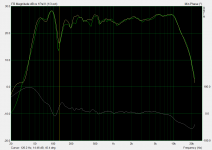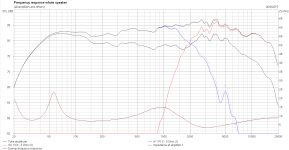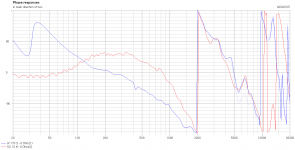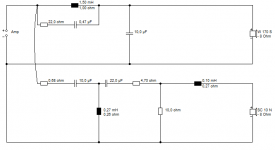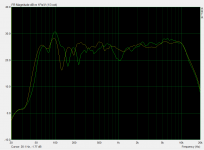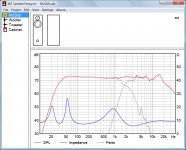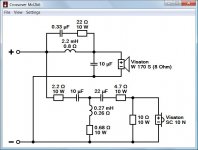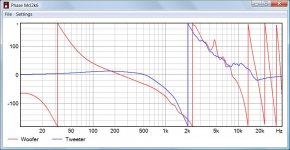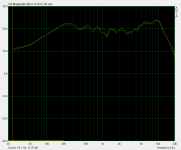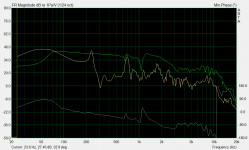Hello all,
I started to do some ARTA measurements with my homebrew speaker system I've presented here in another thread. After a couple of tweaks, I managed to get the higher frequency response pretty even, but what I continue to see is a big dip at around 125Hz. I am wondering, what am I doing wrong?
The system is a two-way, W170-S woofer, and a SC10N as tweeter, crossed over at 2kHz, see the xover design, Visaton boxsim FR, phase, and ARTA measurement files attached.
The mic is a Panasonic WM61-B, with the attached calibration file.
The loudspeaker box has got around 35liters, and currently there is no phono-absorbant material in it.
What I don't understand is where am I getting that big dip at 125Hz from? Is it some due to the W170S response, or am I missing something?
I started to do some ARTA measurements with my homebrew speaker system I've presented here in another thread. After a couple of tweaks, I managed to get the higher frequency response pretty even, but what I continue to see is a big dip at around 125Hz. I am wondering, what am I doing wrong?
The system is a two-way, W170-S woofer, and a SC10N as tweeter, crossed over at 2kHz, see the xover design, Visaton boxsim FR, phase, and ARTA measurement files attached.
The mic is a Panasonic WM61-B, with the attached calibration file.
The loudspeaker box has got around 35liters, and currently there is no phono-absorbant material in it.
What I don't understand is where am I getting that big dip at 125Hz from? Is it some due to the W170S response, or am I missing something?
Attachments
Room reflection, usually the floor: at that frequency the path driver-mic is anti-phase with the path driver-floor-mic. If you want to compare simulation with measure you should perform a gated measure.
Ralf
But that's what I am doing. Single gated FR measurement.
Just measured, the woofer is at 105cm from the floor, thre reflex port is at 60cm or so, and the speaker was at ~105cm too.
I'm using the full length of the recorded stream. Should I do something else?Are you sure you are gating? It's not what I expect to see, and there should be a horizontal yellow line indicating the minimum valid frequency. How long is your gate?
Ralf
Wrong is when you change a decent crossover to the worse, just because measurements with a noncalibrated microphone tell you to do so! 
Sorry for that, but I really liked the previous version of your xo. OK, crossing the SC10N lower than 2 kHz is keen, but everything else looked very nice IMO. Now I'm a little bit shocked to see what you have done to the tweeter. That bump at 2-4 kHz and the corresponding impedance minimum can't be right. Attached is a simulation of the previous version I'm referring to.
Those cheap microphone capsules vary significantly in frequency response, and they also depend on details of mounting (prominent, flush or recessed). Hence it's very unlikely that a general microphone correction file does provide the accuracy needed to rely on.
Back to the topic. The dip at 125 Hz also could be caused by a standing wave in the fully undamped cabinet. The quarter wave length of 125 Hz is about 70 cm, which corresponds more or less to the height of your cabinet.
Sorry for that, but I really liked the previous version of your xo. OK, crossing the SC10N lower than 2 kHz is keen, but everything else looked very nice IMO. Now I'm a little bit shocked to see what you have done to the tweeter. That bump at 2-4 kHz and the corresponding impedance minimum can't be right. Attached is a simulation of the previous version I'm referring to.
Those cheap microphone capsules vary significantly in frequency response, and they also depend on details of mounting (prominent, flush or recessed). Hence it's very unlikely that a general microphone correction file does provide the accuracy needed to rely on.
Back to the topic. The dip at 125 Hz also could be caused by a standing wave in the fully undamped cabinet. The quarter wave length of 125 Hz is about 70 cm, which corresponds more or less to the height of your cabinet.
Attachments
Placing the woofer at half the room height and putting the mic close by will get you the lowest possible valid frequency. That's it, yes you should cut the stream there, the floor and ceiling bounce should be obvious. Of course you can't have the mic too close..
After that it probably matters less. Partly because the bass response is fairly predictable and could be worked out from nearfield measurements. Partly because these frequencies shouldn't necessarily be worked out with equalisation so much as by navigating and treating the room response.
After that it probably matters less. Partly because the bass response is fairly predictable and could be worked out from nearfield measurements. Partly because these frequencies shouldn't necessarily be worked out with equalisation so much as by navigating and treating the room response.
Wrong is when you change a decent crossover to the worse, just because measurements with a noncalibrated microphone tell you to do so!
Sorry for that, but I really liked the previous version of your xo. OK, crossing the SC10N lower than 2 kHz is keen, but everything else looked very nice IMO. Now I'm a little bit shocked to see what you have done to the tweeter. That bump at 2-4 kHz and the corresponding impedance minimum can't be right. Attached is a simulation of the previous version I'm referring to.
You are absolutely right over here! Today morning I had listened the same music as yesterday night, and the speaker is shouting pretty much in the midrange. It seems that the Visaton sim was right. Your results give the same results (rather flat FR), so I think that today I'll be reverting to the old design. I was thinking to open up the midrange a little bit though.
BTW, what software is that you are using?
Those cheap microphone capsules vary significantly in frequency response, and they also depend on details of mounting (prominent, flush or recessed). Hence it's very unlikely that a general microphone correction file does provide the accuracy needed to rely on.
Dunno about this, some chaps on different forums usually praise the WM61 capsules.
Yep, that could be. I'll have to try to use some phono absorbent material. Shall I fill the cabinet with a certain amount, or would it be enough to line the walls with?Back to the topic. The dip at 125 Hz also could be caused by a standing wave in the fully undamped cabinet. The quarter wave length of 125 Hz is about 70 cm, which corresponds more or less to the height of your cabinet.
Last edited:
So you are not gating. See here for an how-to: http://audio.claub.net/tutorials/FR%20measurement%20using%20ARTA.pdfI'm using the full length of the recorded stream. Should I do something else?
Ralf
That's it, I went back to the old xover config, the one Dissi presented too, and it sounds better, it doesn't shout so much.
I attached the measurements for both of the speakers, on one graphic.
I did a gated measurement this time, following the tutorial linked by @giralfino.
Perhaps the treble is a bit brighter, but it is rather nice.
One question to Dissi: how OK is the crossover point? I'm using that 3rd order filter for the tweeter, I guess I shall be fine with it. I was not willing to go above 2kHz because the W170S is not really great over that freq.
I attached the measurements for both of the speakers, on one graphic.
I did a gated measurement this time, following the tutorial linked by @giralfino.
Perhaps the treble is a bit brighter, but it is rather nice.
One question to Dissi: how OK is the crossover point? I'm using that 3rd order filter for the tweeter, I guess I shall be fine with it. I was not willing to go above 2kHz because the W170S is not really great over that freq.
Attachments
Last edited:
Congratulation to your first gated measurement. It looks pretty nice. Of course you lose the low frequencies that way, but you gain accuracy by eliminating all the disturbing room reflections. I think the rise above 4 kHz is a property of your current measurement setup and shouldn't be regarded as reality. The tweeter actually has a peak of some dBs at 14 kHz.
Now you can also try to take a near field measurement of the woofer. I assume gating is not required this time because the SPL of the woofer is much louder than any room reflections. There should be a dip at the tuning frequency. Then you can do the same at the bass reflex port. I'm curious if a dip at 125 Hz shows up.
Vented loudspeakers usually are damped by lining only the walls. The volume stays free in order to not obstruct the bass reflex effect.
Regarding crossover frequency the diplomatic answer is: as low as the tweeter allows. I confess, the Visaton SC10N is a classic 3rd order 3 kHz tweeter in my opinion. But as long as you don't notice any problems it makes absolutely no sense to change your crossover again. If you mostly listen at moderate levels it may be OK. And nobody knows if a 3 kHz version really would be better.
Now you can also try to take a near field measurement of the woofer. I assume gating is not required this time because the SPL of the woofer is much louder than any room reflections. There should be a dip at the tuning frequency. Then you can do the same at the bass reflex port. I'm curious if a dip at 125 Hz shows up.
Vented loudspeakers usually are damped by lining only the walls. The volume stays free in order to not obstruct the bass reflex effect.
Regarding crossover frequency the diplomatic answer is: as low as the tweeter allows. I confess, the Visaton SC10N is a classic 3rd order 3 kHz tweeter in my opinion. But as long as you don't notice any problems it makes absolutely no sense to change your crossover again. If you mostly listen at moderate levels it may be OK. And nobody knows if a 3 kHz version really would be better.
Last edited:
I managed to take some near-field measurements.
For the driver, I've put the mic as close as possible to the dust cap. I've adjusted the output level so that the latter won't hit the mic.
Then I measured the port too - as said in one place, "flush with the system's faceplate".
The results are attached. Good thing: there is no dip at 125Hz. Green line is the driver, yellow is the port.
For the driver, I've put the mic as close as possible to the dust cap. I've adjusted the output level so that the latter won't hit the mic.
Then I measured the port too - as said in one place, "flush with the system's faceplate".
The results are attached. Good thing: there is no dip at 125Hz. Green line is the driver, yellow is the port.
Attachments
- Status
- This old topic is closed. If you want to reopen this topic, contact a moderator using the "Report Post" button.
- Home
- Loudspeakers
- Multi-Way
- Visaton system - what is wrong here?
